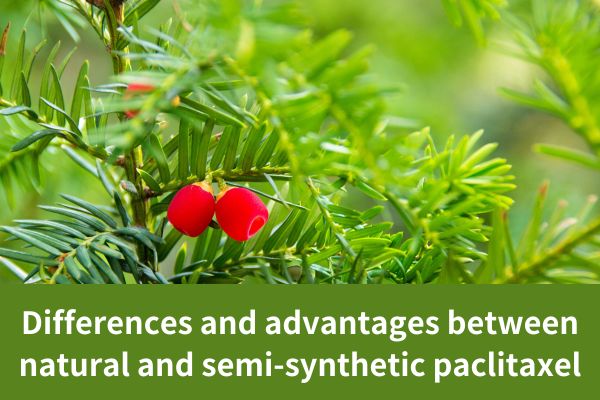Paclitaxel is an important anticancer drug,and its unique structure and biological activity have attracted much attention from scientists.According to its source and preparation method,paclitaxel can be divided into natural paclitaxel and semi-synthetic paclitaxel.This article will discuss the differences and advantages of the two.
Source and preparation method
Natural paclitaxel:Natural paclitaxel is mainly extracted from the Pacific yew tree(Taxus brevifolia).This tree is rich in paclitaxel,but in limited quantities,making the supply of natural paclitaxel relatively scarce.
Semi-synthetic paclitaxel:Semi-synthetic paclitaxel is synthesized by chemical synthesis from taxanes extracted from the bark of taxus chinensis.This method can be used to produce paclitaxel on a large scale to meet clinical needs.
Chemical structure
Although natural paclitaxel and semi-synthetic paclitaxel differ slightly in chemical structure,their core structure is the same,and both are diterpenoid alkaloids.This unique structure gives them a common biological activity.
Biological activity and efficacy
Natural paclitaxel:In clinical practice,natural paclitaxel has been shown to have a significant therapeutic effect on a variety of cancers,including breast cancer,ovarian cancer,some head and neck cancers,and lung cancer.Its anticancer activity is mainly through inhibiting the polymerization of tubulin and destroying the cell microtubule network,thus inhibiting cell proliferation and inducing apoptosis of cancer cells.
Semi-synthetic paclitaxel:Semi-synthetic paclitaxel is similar in efficacy to natural paclitaxel and also has significant anticancer activity.Mass production of semi-synthetic paclitaxel could increase the clinical supply and provide more treatment options for cancer patients.
Toxic side effects
Natural paclitaxel:The toxicity of natural paclitaxel is relatively low,but it may still cause some adverse reactions,such as allergic reactions,bone marrow suppression and cardiac toxicity.
Semi-synthetic paclitaxel:The side effects of semi-synthetic paclitaxel are similar to those of natural paclitaxel.Both require rational medication based on individual circumstances and physician recommendations to reduce the risk of adverse reactions.
Future development Prospects
With the continuous progress of science and technology,the research on paclitaxel is also deepening.In the future,the scientists will work to find more efficient methods of paclitaxel synthesis to further optimize its production process and improve clinical efficacy.At the same time,with the development of emerging technologies such as genetic engineering and cell therapy,personalized treatment strategies for paclitaxel will also be possible,thus providing cancer patients with more accurate and effective treatment options.
Conclusion
Both natural paclitaxel and semi-synthetic paclitaxel have significant anticancer activity in clinical practice.Although their origin and preparation methods are different,they share similarities in chemical structure,biological activity and pharmacodynamics.The large-scale production of semi-synthetic paclitaxel can increase the clinical supply,while natural paclitaxel has a richer source potential.In future studies,scientists will continue to explore the biological mechanisms of action and application areas of paclitaxel to bring more therapeutic hope to cancer patients.
Note:The potential benefits and applications presented in this article are derived from the published literature.
Post time: Nov-29-2023
